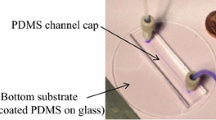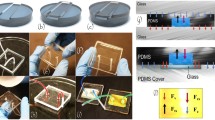Abstract
In this paper, we introduce a new bonding technology for the assembly of micro- structured glass substrates for miniaturized chemical analysis. The protocol features a facile polymer chemistry method processing at lower temperatures (<100 °C). The method consisted of a proper cleaning of the two glass surfaces, followed by hydroxylization, aminosilylation and hyperbranched polyurethane oligomers (HPU) bridging on quartz wafer surfaces as the interlayer. Strong bonding with a shear force 4.5 MPa has been achieved. The present procedure avoids the possible micro-channel blockage and contamination by using conventional adhesives. Moreover, the microfluidic chips bonded by the above procedures are highly transparent therefore allowing for biochemical compositions to be easily characterized by UV–vis or IR spectroscopy.




Similar content being viewed by others
References
Abgrall P, Nguyen NT (2008) Nanofluidic devices and their applications. Anal Chem 80(7):2326–2341
Chen LX, Luo GA, Liu KH, Ma JP, Yao B, Yan YC, Wang YM (2006) Bonding of glass-based microfluidic chips at low- or room-temperature in routine laboratory. Sens Actuators B 119:335–344
Coffinier Y, Olivier C, Perzyna A, Grandidier B, Wallart X, Durand JO, Melnyk O, Stiévenard D (2005) Semicarbazide functionalized Si(111) surfaces for the site-specific immobilization of peptides. Langmuir 21(4):1489–1496
Díaz-González M, Baldi A (2012) Fabrication of biofunctionalized microfluidic structures by low-temperature wax bonding. Anal Chem 84(18):7838–7844
Dykstra PH, Roy V, Byrd C, Bentley WE, Ghodssi R (2011) Microfluidic electrochemical sensor array for characterizing protein interactions with various functionalized surfaces. Anal Chem 83(15):5920–5927
Karabudak E, Kas R, Ogieglo W, Rafieian D, Schlautmann S, Lammertink RGH, Gardeniers HJGE, Mul G (2013) Disposable attenuated total reflection-infrared crystals from silicon wafer: a versatile approach to surface infrared spectroscopy. Anal Chem 85(1):33–38
Lasky JB (1986) Wafer bonding for silicon-on-insulator technologies. Appl Phys Lett 48(1):78–80
Lee CC, Chiang HP, Li KL, Ko FH, Su CY, Yang YS (2009) Surface reaction limited model for the evaluation of immobilized enzyme on planar surfaces. Anal Chem 81(7):2737–2744
Lee YC, Kim JW, Kim Y, Jung SB (2013) Reliability of chip on glass module fabricated with direct printing method. Microelectron Eng 107:114–120
Liu TH, Ding L, He G, Yang Y, Wang WL, Fang Y (2011) Photochemical stabilization of terthiophene and its utilization as a new sensing element in the fabrication of monolayer-chemistry-based fluorescent sensing films. ACS Appl Mater Interfaces 3(4):1245–1253
Liu WJ, Zhang YX, Hou SH, Zhao ZBK (2013) Synthesis of isoprenoid chain-contained chemical probes for an investigation of molecular interactions by using quartz crystal microbalance. Tetrahedron Lett 54(46):6208–6210
Maszara WP, Goetz G, Caviglia A, McKitterick JB (1988) Bonding of silicon wafers for Silicon-On-Insulator. J Appl Phys 64:4943–4950
Mirasoli M, Guardigli M, Michelini E, Roda A (2014) Recent advancements in chemical luminescence-based lab-on-chip and microfluidic platforms for bioanalysis. J Pharm Biomed Anal 87(18):36–52
Moon JH, Shin JW, Kim SY, Park JW (1996) Formation of uniform aminosilane thin layers: an imine formation to measure relative surface density of the amine group. Langmuir 12:4621–4624
Moon JH, Kim JH, Kim KJ, Kang TH, Kim B, Kim CH, Hahn JH, Park JW (1997) Absolute surface density of the amine group of the aminosilylated thin layers: ultraviolet-visible spectroscopy, second harmonic generation, and synchrotron- radiation photoelectron spectroscopy study. Langmuir 13:4305–4310
Nakanishi H, Nishimoto T, Kanai M, Saitoh T, Nakamura K, Shoji S (1999) Condition optimization, reliability evaluation of SiO2–SiO2 HF bonding and its application for UV detection micro flow cell. In: Proc. Transducers 99, Sendai, Japan 1332
Poenar DP, Iliescu C, Carp M, Pang AJ, Leck KJ (2007) Glass-based microfluidic device fabricated by parylene wafer-to-wafer bonding for impedance spectroscopy. Sens Actuators A: Physical 139:162–171
Ramos LA, Ulic SE, Romano RM, Vishnevskiy YV, Berger RJF, Mitzel NW, Beckers H, Willner H, Tong SR, Ge MF, Della Védova CO (2012) chlorodifluoroacetyl isocyanate, ClF2CC(O)NCO: preparation and structural and spectroscopic studies. J Phys Chem A 116(47):11586–11595
Schmidt MA (1998) Wafer-to-wafer bonding for microstructure formation. Proc IEEE 86:1575
Sharma CS, Sharma A, Madou M (2010) Multiscale carbon structures fabricated by direct micropatterning of electrospun mats of SU-8 photoresist nanofibers. Langmuir 26(4):2218–2222
Shimbo M, Furukawa K, Fukuda K, Tanzawa K (1986) Silicon-to-silicon direct bonding method. J Appl Phys 60:2987–2989
Smith RL, Collins SD (1988) Micromachined packaging for chemical microsensors. IEEE Trans Electron Devices ED 35:787–792
Vander Groen S, Rosmeulen M, Baert K, Jansen P, Deferm L (1997) Substrate bonding techniques for CMOS processed wafers. J Micromech Microeng 7:108–110
Vilkner T, Janasek D, Manz A (2004) Micro total analysis systems, recent developments. Anal Chem 76(12):3373–3386
Vladisavljević GT, Khalid N, Neves MA, Kuroiwa T, Nakajima M, Uemura K, Ichikawa S, Kobayashi I (2013) Industrial lab-on-a-chip: design, applications and scale-up for drug discovery and delivery. Adv Drug Deliv Rev 65(11–12):1626–1663
Wei J, Nai SML, Wong CKS, Sun Z, Lee LC (2003) Low temperature glass-to-glass bonding. IEEE Trans Adv Packag 26(3):289–294
Zhao JY, Shang ZP, Gao LX (2007) Bonding quartz wafers by the atom transfer radical polymerization of the glycidyl methacrylate at mild temperature. Sens Actuators A 35:257–261
Author information
Authors and Affiliations
Corresponding authors
Rights and permissions
About this article
Cite this article
Zhao, J., Jin, F., Zhao, J. et al. Low-temperature quartz wafer bonding using hyperbranched polyurethane oligomers. Microsyst Technol 21, 1473–1478 (2015). https://doi.org/10.1007/s00542-014-2258-9
Received:
Accepted:
Published:
Issue Date:
DOI: https://doi.org/10.1007/s00542-014-2258-9




